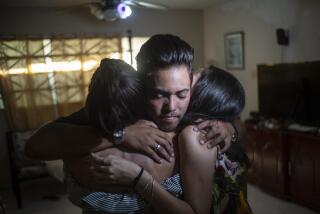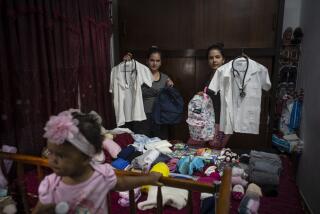In Cuba, reactions to thaw with U.S. run from cold to warm

- Share via
Reporting from HAVANA — The weekly ritual was underway. Silent and holding fake fuchsia-colored gladioluses, the Ladies in White paraded from church and down 5th Avenue in residential Havana to demand the release of political prisoners and, on this Sunday, to decry the Obama administration’s rapprochement with Cuba.
Among the most strident enemies of successive Castro governments, the mood was downcast. Activists said Cuban President Raul Castro gave up very little to gain a great deal.
“By ending the blockade,” said Maria Cristina Labrada, using the word with which Cubans refer to the U.S. embargo, President Obama “is only strengthening the repression against us.”
Labrada was one of about 70 women participating in the march. A small group of men stood to one side of the avenue, holding up their hands in the shape of an L for libertad, or “freedom.”
To the Cuban activists, Castro has emerged a winner in the 55-year-long standoff with the United States, sealing his legacy as the Cuban leader who would oversee official recognition by the giant neighbor to the north. Cuba released Alan Gross, a subcontractor with the U.S. Agency for International Development, who had been jailed on the island for five years, and a few other prisoners. But the release of more than 50 people promised as part of the deal has yet to materialize, activists said.
“They can let 53 go, but we are all exposed. Anyone can fall” prisoner, said another of the white-clad women, Lazara Sardiña.
The embargo has not been lifted; only Congress can do that. But Obama did restore diplomatic relations with the island, severed in 1961, making it easier for businesses to work and invest on the island and for interaction to be the norm.
The more common reaction in Cuba to what many hope is a new era has been a delighted anticipation, filled with dreams of travel and trade, but tempered by uncertainty over what exactly the future holds. Most Cubans today have known only a president named Castro and have been ingrained with the steady drumbeat of hostilities between Havana and Washington.
“I really like your president for doing this,” said Misael Lopez, 44, a driver. “I love Cuba, but my wife and daughter are there [in the U.S.], and if I can travel freely that will make me really, really happy.”
Change had already started. Castro has slightly opened the economy, allowing private entrepreneurs to run businesses. Restaurants, beauty parlors, repair shops have sprung up all over Havana. He eliminated the hated travel permit that Cubans needed to leave the country. Cubans are now allowed to sell real estate and cars for the first time in nearly 50 years.
And now, the piece de resistance: diplomatic relations with the United States.
Absent in the most recent moves is the man who arguably started it all. Fidel Castro, who fell ill in 2006 and officially stepped down from the presidency in 2008 after leading his nation for nearly five decades, has not been seen in public for a long time and has made no comments about the most significant development here in more than a generation.
It has been a matter of debate for a long time what Fidel Castro’s role is. Some of Raul Castro’s supporters accuse Fidel Castro of tying his brother’s hands, slowing his movements toward reform. Others say Fidel Castro has faded completely.
“This is Raul’s moment,” said Reinaldo Escobar, an editor at a new Web newsletter — itself a sign of the changes happening in Cuba. “The silence of Fidel is the formal certificate of his political death.”
Whether that’s because the 88-year-old Fidel Castro is so physically infirm or he has simply ceded control to his brother — only five years his junior — is not known. Several analysts in Cuba contend that Raul has been able to do what Fidel simply couldn’t, given the latter’s history and trajectory.
“Changes have been going in the right direction,” Escobar said, “but not at the necessary depth nor the speed.”
Before Sunday’s march by the Ladies in White, a fairly full Roman Catholic church celebrated the coming of Christmas. Sparkling Christmas trees and a neon-blue nativity scene decorated the altar. Father Jose Felix made no overt political references — except for scolding foreign journalists who invaded the sanctuary — but spoke of the reconciliation of the Cuban family.
Prayer was deep; hymns were deep-throated. The church is the parish of St. Rita: as a poster by the altar says, “Santa Rita: Advocate for what is impossible.”
Twitter: @TracyKWilkinson
More to Read
Sign up for Essential California
The most important California stories and recommendations in your inbox every morning.
You may occasionally receive promotional content from the Los Angeles Times.












